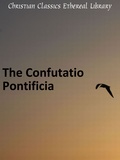Confutatio Pontificia
by Anonymous
Summary
In June of 1530, the leaders of the Protestant Reformation and the principalities of the Holy Roman Empire gathered in Augsburg to discuss religious convictions in an attempt by the Emperor, Charles V, to restore religious and political unity. This, however, was not achieved. The reformers presented what is now titled The Augsburg Confession, setting out their beliefs. Charles issued an official response to be written, refuting that which the Vatican did not uphold to be true. This document was the Confutatio Pontificia, primarily written by the theologian Johann Eck. Its composition brought about a response by the reformers called The Apology of the Augsburg Confession; this, along with the Confession itself, have become two of the primary documents of the Lutheran faith. The Confutatio is thus an important read for two reasons: it outlines much of the Roman Catholic faith, and gives us a clearer understanding of the Protestant Reformation and Lutheran Theology.
Laura de Jong
CCEL Staff Writer
Laura de Jong
CCEL Staff Writer
Popularity
Available formats
